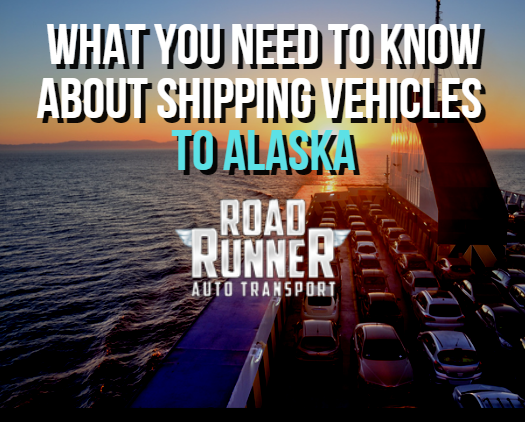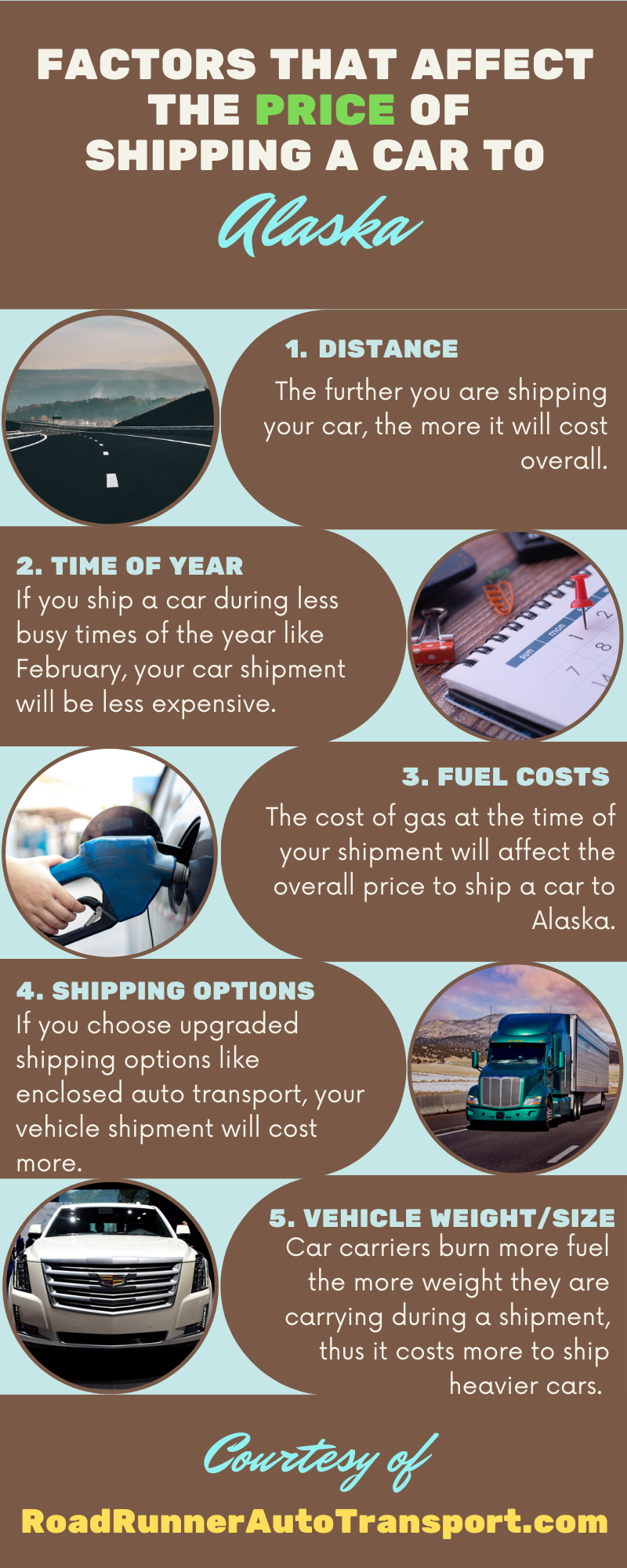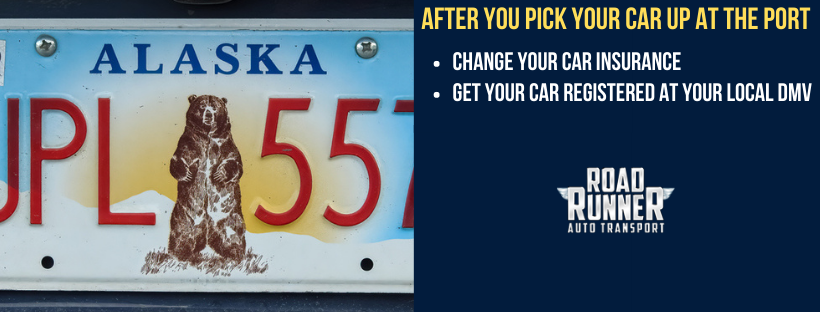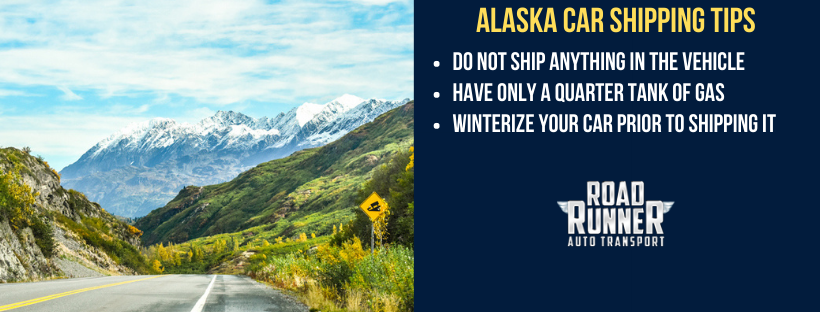
The trusted name in vehicle shipping for over 30 years!
- Track a Shipment
- Dealer Login
- Carrier Login
Speak with a shipping expert
(888) 777-2123

What You Need to Know About Shipping Vehicles to Alaska
Posted on 03/01/2023
- Your car will ship over the ocean
- How long will it take to ship a car to Alaska?
- How much does it cost to ship a car to Alaska
- Shipping a car to Alaska military bases
- Picking your car up at the port
- What you need to do with your car after you pick it up at the port in Alaska
- Other possible ways to get a vehicle to Alaska
- Alaska car shipping tips
- Conclusion

Your car will ship over the ocean
When you ship a car to Alaska, the vast majority of car shipping companies will actually ship your car on a cargo ship from the port at Seattle to Alaska rather than driving the shipment through Canada. There are two reasons for this:
- Several popular Alaskan shipping locations are only accessible or much more easily accessible via the ocean
- Crossing the Canadian border then crossing back over the American border greatly increases transit time as well as overall shipping cost
The only thing that really changes on your end since your car will be shipped for part of the journey on a cargo ship is the maximum amount of gas that you can have in it. For a car shipment that gets shipped entirely on the ground on a typical auto carrier, you just need to have enough gas in order for the car to be driven onto and off of the carrier. There is no amount that is “too much” so your gas tank could be full without causing an issue.
With a car shipment that makes all of or part of its journey on a cargo ship, you cannot have more than a quarter tank of gas due to fire regulations. However, your car will also need to be driven onto and off of the cargo ship as well as the auto carrier, so too much less than a quarter tank is not ideal either. You should do your best to get as close to a quarter tank of gas as possible when you are shipping a car to Alaska.
How long will it take to ship a car to Alaska
You might find yourself wondering how long a vehicle shipment to Alaska might take since it needs to be transported on a ship for a portion of the journey. The following are expected transit times for shipping a vehicle to Alaska from several popular origin locations throughout the United States:
How much does it cost to ship a car to Alaska?
When you ship your vehicle to Alaska, the overall price that it will cost will vary depending on multiple factors. How far you are shipping your car, when you are shipping it, the cost of gas at the time of your shipment, which shipping options you selected, and the size of your vehicle will all play a considerable role in the price you end up paying for your Alaskan car shipment. A car shipment to Alaska will cost between fifty cents and two dollars per mile. So, if you take the median price of that range at $0.75 and apply that to a shipment of exactly 1,700 miles, your auto transport cost for shipping to Alaska would total $1,275.
When you are looking for the cheapest way to ship a car to Alaska, try to avoid selecting any upgraded shipping options such as top loading . Also, try to give your Alaska auto transport company at least four weeks’ notice of your shipment because rates tend to remain lower when a maximum amount of spaces are available on a carrier. If you can, try to avoid shipping your car to Alaska during a busier time of the year such as over the summer.

Shipping a car to Alaska military bases
Some people end up shipping a car to Alaska for a military move. If that is the case for you and your family, you might want to know if we can ship your car to a port near your new base. You also might want to know if you can possibly get any of the cost of your car shipment covered by the military. This tends to be on a case-by-case basis. Some things that could impact how much the military will cover of your car shipment to Alaska will be your base location, your rank/number of years of service and what your particular assignment designation is.
There are currently eight military bases located in Alaska which are mostly Coast Guard and Air Force bases due to Alaska’s ease of accessibility via the air and sea versus the ground. The following is a list of these bases with their closest port and the estimated distance between them:
Picking your car up at the port in Alaska
When you ship a car to Alaska, it can be picked up at your home anywhere nationwide in the United States. However, you will need to pick it up at the port in Alaska. Unfortunately, there are an extremely small number of auto carrier trucks available in Alaska thus your car cannot be shipped any further than the port.
The following are the ports that you can get a vehicle shipped to in Alaska:
- Anchorage
- Dutch Harbor
- Fairbanks
- Valdez
- Juneau
- Kodiak
- Sitka
- Petersburg
- Wrangell
- Craig
- Kake
- Hoonah
- Haines
- Skagway
- Yakutat
- Cordova
- Thorne Bay
- Ketchikan
What you need to do with your car after you pick it up at the port in Alaska
After you pick your car up at the port, you will be able to easily obtain a temporary out-of-state registration for sixty days. After that, you must get your car officially registered in Alaska which means you will also need to change your car insurance so that it is current in Alaska. If you are moving permanently to Alaska, you will also need to get a new Alaska state license as well as new Alaska state license plates for your vehicle.

Changing your car insurance
You should start this process by switching your car insurance coverage so that it is valid in Alaska. You can do this by:
- Do your research and make sure that your new coverage will meet minimum auto insurance coverage requirements in Alaska which are $50,000.00 for injuries or death to any one person, $100,000.00 for total injuries or death per collision, and $25,000.00 for property damages.
- Comparison shop between providers so that you will pay the lowest possible premium each month based on your past driving record.
- Complete the required documentation and get in touch with your insurance company to be sure that the change has officially been made before you arrive at the port to pick up your vehicle.
Getting your car registered in Alaska
Once you have changed your car insurance, you can then start the process of getting your car registered in Alaska. In order to get your car registered in Alaska:
- Have the car’s title ready
- Fill out the Application for Title and Registration
- Have a VIN inspection conducted by a DMV-approved individual
- Pay all applicable registration fees and taxes
Other possible ways to get a vehicle to Alaska
There are several other options in terms of transporting a vehicle to Alaska from another state. This includes shipping the car via plane, driving the car through Canada all the way to Alaska, towing it through Canada to Alaska, or having someone else drive it all the way there.
Shipping a car to Alaska on a plane as freight is technically an option for moving a car to Alaska but is not often used. You will need to drive your car to the airport or airfield as well as pick up from the airfield in Alaska after delivery. Choosing this method of transport is also typically at least twice as expensive as traditional car shipping.
When you choose to drive your car to Alaska from another US state, you will need to put several hundred if not thousands of miles on the car. You will also need to make a trip that will likely take several days’ time. Worst of all, you will need to cross the US/Canada border and the Canada/US border in order to successfully get your vehicle to Alaska. You will run into all the same issues if you choose to tow your car to Alaska. You will also end up spending even more time on the road if you tow your vehicle because of all the extra weight. You will also burn more fuel due to all the extra weight as well.
If you choose to hire someone to drive your car to Alaska, you will not only be putting hundreds or thousands of miles of depreciation on the car, but you will be leaving the safety of the car up to someone else driving it all that way. When you ship your car, another person will be responsible for your car, but it will only be driven onto and off of the car carrier and cargo ship. Otherwise, it will not be operated and will always be safely secured.
Alaska car shipping tips
As we mentioned earlier, your car’s fuel level is more important when you ship it to Alaska than it is when you ship it anywhere else due to fire regulations. So, do your very best to ensure you have as close to a quarter tank of gas as possible.
Before you book your shipment with one company, do some research online and read past customer reviews on websites like Google and Consumer Affairs. If they have a good rating and past customers seem generally satisfied, then you should go ahead and book your Alaska car transport.
In addition to the gas requirement, there will be a few other simple steps of preparation that you will need to take in order to be ready for your car shipment to Alaska. Prior to your auto transport driver arriving to pick up your vehicle you must:
- Clean the outside of your vehicle so your car shipping driver will be able to quickly check for any damage that existed prior to shipping.
- Ensure that your car is in good working order. This includes checking your battery, your engine and your tires. If you encounter any issues, be sure to get them repaired right away.
Always do your best to avoid shipping anything in your vehicle either on purpose or by accident. If these things end up lost or incur any damage when your vehicle ships, you will have to pay for a replacement or repair on your own. The vehicle transport coverage will unfortunately not cover anything that is not a physical part of the car.
If you are shipping in the winter or to an Alaska location located further north such as Fairbanks, you should consider weatherproofing your vehicle before you ship it. In Alaska, you will likely deal with a considerable amount of snow and ice out on the road, so it is important to be ready. In order to weatherproof a car for Alaska’s winter you should:
- Change your wiper blades – If you have regular or stock wiper blades on your vehicle, switch them to winter wiper blades.
- Change your tires – If you do not already have winter tires on, get them installed on your car. Winter tires will offer you much more traction on snow and ice than traditional tires will, which can make it much easier to drive throughout the winter in Alaska.
- Make sure your car battery is not about to die and can stand very cold temperatures – If your car battery is particularly old or if it has a low CCA number (cold cranking amps), it might not be suitable to use in Alaska. If this is the case, get the battery replaced with one that will perform well in harsh winter cold.
- Make sure that your tires are properly inflated – At the very least, ensure your tires are not significantly underinflated prior to shipping to Alaska in the winter. However, consider adding an extra (two to five) few PSI of pressure to your tires before shipping as well. Cold temperatures will cause your tires to lose a bit of pressure once the car arrives in Alaska.
- Replenish your vehicle’s fluids – You must also ensure that you check and replace or replenish any of the following automotive fluids prior to shipping to Alaska over the winter:
- Transmission fluid
- Brake fluid
- Power steering fluid
- Wiper fluid
- Engine coolant
- Change your oil – Having fresh oil in your engine will help it resist cold weather better which will improve your engine’s ability to properly run.

Conclusion
Shipping a car to Alaska does mean your car will need to ship via the sea as well as on the ground. It will also mean that you will have to pick your car up at the port in Alaska rather than having it delivered to your door. Regardless, it will still be an incredibly simple process from the time that you start researching potential Alaska auto transporters to the moment you start driving your car away from the port. You will just need to choose a shipping company, book your shipment, do some quick preparation for your shipment and pick your car up at the port. If you need your car shipped to Alaska, you can always give RoadRunner Auto Transport a call at (888)777-2123 for a free instant quote!
Instant Car Shipping Quote
Calculate your car shipping rate in 3 easy steps!
What You Need to Know About Shipping Vehicles to Alaska
Posted on 03/01/2023
- Your car will ship over the ocean
- How long will it take to ship a car to Alaska?
- How much does it cost to ship a car to Alaska
- Shipping a car to Alaska military bases
- Picking your car up at the port
- What you need to do with your car after you pick it up at the port in Alaska
- Other possible ways to get a vehicle to Alaska
- Alaska car shipping tips
- Conclusion

Your car will ship over the ocean
When you ship a car to Alaska, the vast majority of car shipping companies will actually ship your car on a cargo ship from the port at Seattle to Alaska rather than driving the shipment through Canada. There are two reasons for this:
- Several popular Alaskan shipping locations are only accessible or much more easily accessible via the ocean
- Crossing the Canadian border then crossing back over the American border greatly increases transit time as well as overall shipping cost
The only thing that really changes on your end since your car will be shipped for part of the journey on a cargo ship is the maximum amount of gas that you can have in it. For a car shipment that gets shipped entirely on the ground on a typical auto carrier, you just need to have enough gas in order for the car to be driven onto and off of the carrier. There is no amount that is “too much” so your gas tank could be full without causing an issue.
With a car shipment that makes all of or part of its journey on a cargo ship, you cannot have more than a quarter tank of gas due to fire regulations. However, your car will also need to be driven onto and off of the cargo ship as well as the auto carrier, so too much less than a quarter tank is not ideal either. You should do your best to get as close to a quarter tank of gas as possible when you are shipping a car to Alaska.
How long will it take to ship a car to Alaska
You might find yourself wondering how long a vehicle shipment to Alaska might take since it needs to be transported on a ship for a portion of the journey. The following are expected transit times for shipping a vehicle to Alaska from several popular origin locations throughout the United States:
How much does it cost to ship a car to Alaska?
When you ship your vehicle to Alaska, the overall price that it will cost will vary depending on multiple factors. How far you are shipping your car, when you are shipping it, the cost of gas at the time of your shipment, which shipping options you selected, and the size of your vehicle will all play a considerable role in the price you end up paying for your Alaskan car shipment. A car shipment to Alaska will cost between fifty cents and two dollars per mile. So, if you take the median price of that range at $0.75 and apply that to a shipment of exactly 1,700 miles, your auto transport cost for shipping to Alaska would total $1,275.
When you are looking for the cheapest way to ship a car to Alaska, try to avoid selecting any upgraded shipping options such as top loading . Also, try to give your Alaska auto transport company at least four weeks’ notice of your shipment because rates tend to remain lower when a maximum amount of spaces are available on a carrier. If you can, try to avoid shipping your car to Alaska during a busier time of the year such as over the summer.

Shipping a car to Alaska military bases
Some people end up shipping a car to Alaska for a military move. If that is the case for you and your family, you might want to know if we can ship your car to a port near your new base. You also might want to know if you can possibly get any of the cost of your car shipment covered by the military. This tends to be on a case-by-case basis. Some things that could impact how much the military will cover of your car shipment to Alaska will be your base location, your rank/number of years of service and what your particular assignment designation is.
There are currently eight military bases located in Alaska which are mostly Coast Guard and Air Force bases due to Alaska’s ease of accessibility via the air and sea versus the ground. The following is a list of these bases with their closest port and the estimated distance between them:
Picking your car up at the port in Alaska
When you ship a car to Alaska, it can be picked up at your home anywhere nationwide in the United States. However, you will need to pick it up at the port in Alaska. Unfortunately, there are an extremely small number of auto carrier trucks available in Alaska thus your car cannot be shipped any further than the port.
The following are the ports that you can get a vehicle shipped to in Alaska:
- Anchorage
- Dutch Harbor
- Fairbanks
- Valdez
- Juneau
- Kodiak
- Sitka
- Petersburg
- Wrangell
- Craig
- Kake
- Hoonah
- Haines
- Skagway
- Yakutat
- Cordova
- Thorne Bay
- Ketchikan
What you need to do with your car after you pick it up at the port in Alaska
After you pick your car up at the port, you will be able to easily obtain a temporary out-of-state registration for sixty days. After that, you must get your car officially registered in Alaska which means you will also need to change your car insurance so that it is current in Alaska. If you are moving permanently to Alaska, you will also need to get a new Alaska state license as well as new Alaska state license plates for your vehicle.

Changing your car insurance
You should start this process by switching your car insurance coverage so that it is valid in Alaska. You can do this by:
- Do your research and make sure that your new coverage will meet minimum auto insurance coverage requirements in Alaska which are $50,000.00 for injuries or death to any one person, $100,000.00 for total injuries or death per collision, and $25,000.00 for property damages.
- Comparison shop between providers so that you will pay the lowest possible premium each month based on your past driving record.
- Complete the required documentation and get in touch with your insurance company to be sure that the change has officially been made before you arrive at the port to pick up your vehicle.
Getting your car registered in Alaska
Once you have changed your car insurance, you can then start the process of getting your car registered in Alaska. In order to get your car registered in Alaska:
- Have the car’s title ready
- Fill out the Application for Title and Registration
- Have a VIN inspection conducted by a DMV-approved individual
- Pay all applicable registration fees and taxes
Other possible ways to get a vehicle to Alaska
There are several other options in terms of transporting a vehicle to Alaska from another state. This includes shipping the car via plane, driving the car through Canada all the way to Alaska, towing it through Canada to Alaska, or having someone else drive it all the way there.
Shipping a car to Alaska on a plane as freight is technically an option for moving a car to Alaska but is not often used. You will need to drive your car to the airport or airfield as well as pick up from the airfield in Alaska after delivery. Choosing this method of transport is also typically at least twice as expensive as traditional car shipping.
When you choose to drive your car to Alaska from another US state, you will need to put several hundred if not thousands of miles on the car. You will also need to make a trip that will likely take several days’ time. Worst of all, you will need to cross the US/Canada border and the Canada/US border in order to successfully get your vehicle to Alaska. You will run into all the same issues if you choose to tow your car to Alaska. You will also end up spending even more time on the road if you tow your vehicle because of all the extra weight. You will also burn more fuel due to all the extra weight as well.
If you choose to hire someone to drive your car to Alaska, you will not only be putting hundreds or thousands of miles of depreciation on the car, but you will be leaving the safety of the car up to someone else driving it all that way. When you ship your car, another person will be responsible for your car, but it will only be driven onto and off of the car carrier and cargo ship. Otherwise, it will not be operated and will always be safely secured.
Alaska car shipping tips
As we mentioned earlier, your car’s fuel level is more important when you ship it to Alaska than it is when you ship it anywhere else due to fire regulations. So, do your very best to ensure you have as close to a quarter tank of gas as possible.
Before you book your shipment with one company, do some research online and read past customer reviews on websites like Google and Consumer Affairs. If they have a good rating and past customers seem generally satisfied, then you should go ahead and book your Alaska car transport.
In addition to the gas requirement, there will be a few other simple steps of preparation that you will need to take in order to be ready for your car shipment to Alaska. Prior to your auto transport driver arriving to pick up your vehicle you must:
- Clean the outside of your vehicle so your car shipping driver will be able to quickly check for any damage that existed prior to shipping.
- Ensure that your car is in good working order. This includes checking your battery, your engine and your tires. If you encounter any issues, be sure to get them repaired right away.
Always do your best to avoid shipping anything in your vehicle either on purpose or by accident. If these things end up lost or incur any damage when your vehicle ships, you will have to pay for a replacement or repair on your own. The vehicle transport coverage will unfortunately not cover anything that is not a physical part of the car.
If you are shipping in the winter or to an Alaska location located further north such as Fairbanks, you should consider weatherproofing your vehicle before you ship it. In Alaska, you will likely deal with a considerable amount of snow and ice out on the road, so it is important to be ready. In order to weatherproof a car for Alaska’s winter you should:
- Change your wiper blades – If you have regular or stock wiper blades on your vehicle, switch them to winter wiper blades.
- Change your tires – If you do not already have winter tires on, get them installed on your car. Winter tires will offer you much more traction on snow and ice than traditional tires will, which can make it much easier to drive throughout the winter in Alaska.
- Make sure your car battery is not about to die and can stand very cold temperatures – If your car battery is particularly old or if it has a low CCA number (cold cranking amps), it might not be suitable to use in Alaska. If this is the case, get the battery replaced with one that will perform well in harsh winter cold.
- Make sure that your tires are properly inflated – At the very least, ensure your tires are not significantly underinflated prior to shipping to Alaska in the winter. However, consider adding an extra (two to five) few PSI of pressure to your tires before shipping as well. Cold temperatures will cause your tires to lose a bit of pressure once the car arrives in Alaska.
- Replenish your vehicle’s fluids – You must also ensure that you check and replace or replenish any of the following automotive fluids prior to shipping to Alaska over the winter:
- Transmission fluid
- Brake fluid
- Power steering fluid
- Wiper fluid
- Engine coolant
- Change your oil – Having fresh oil in your engine will help it resist cold weather better which will improve your engine’s ability to properly run.

Conclusion
Shipping a car to Alaska does mean your car will need to ship via the sea as well as on the ground. It will also mean that you will have to pick your car up at the port in Alaska rather than having it delivered to your door. Regardless, it will still be an incredibly simple process from the time that you start researching potential Alaska auto transporters to the moment you start driving your car away from the port. You will just need to choose a shipping company, book your shipment, do some quick preparation for your shipment and pick your car up at the port. If you need your car shipped to Alaska, you can always give RoadRunner Auto Transport a call at (888)777-2123 for a free instant quote!
"The driver was professional and courteous. Very pleased with my entire experience with RoadRunner Auto Transport."
Sally D.
Atlanta, GA


"Very easy to book and great with answering my questions. The shipping agent I spoke with was very friendly and helpful."
Susan K.
Dallas, TX


"Everything with RoadRunner went smooth and seamless. They gave me a great rate and provided excellent service!"
Owen A.
Hartford, CT


"We needed 2 cars shipped across the country last minute and RoadRunner really came through big time for us!"
Amanda M.
Los Angeles, CA


Frequently Asked Questions
Get answers to some of the most commonly asked questions about the vehicle transportation process.








